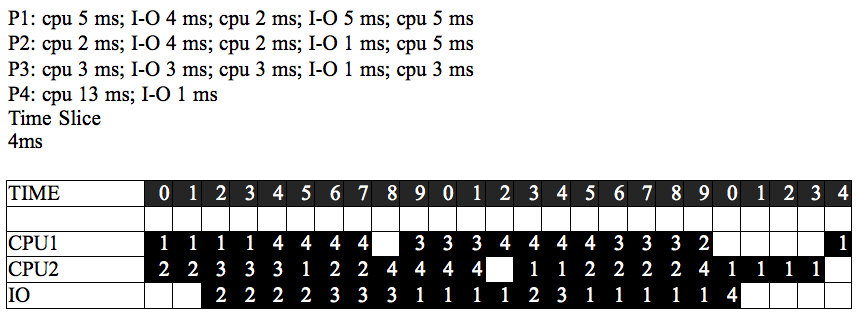Prova Teorica 2013.02.14
(Redirected from Prova Teorica 14-02-2013)
Jump to navigation
Jump to search
Testo del compito
Esercizio C.1
Soluzione di MV
Scrivere un monitor dualwriter che realizzi un doppio buffer limitato (ogni buffer ha ampiezza BUFSIZE) che consenta a uno scrittore di scrivere contemporaneamente due elementi che andranno rispettivamente nel primo e nel secondo buffer. Le letture :
procedure entry void write(type1 e1, type2 e2);
procedure entry type1 read1();
procedure entry type2 read2();
La funzione write deve attendere che ci sia spazio in entrambi i buffer.
La funzione read attende che vi sia almeno un elemento nel buffer indicato.
// ------------------------- SOLUZIONE DI MV -------------------------
monitor dualwriter
{
type1 buf1[BUFSIZE];
type2 buf2[BUFSIZE];
int next_r1, next_r2, n1, n2;
// si ricorda che: next_w = (next_r+n)%BUFSIZE
condition notempty1, notempty2; // blocca in lettura se n=0
condition canwrite; // blocca in scrittura se n1=BUFSIZE || n2=BUFSIZE
dualwriter() // costruttore
{
n1 = n2 = next_r1 = next_r2 = 0;
}
procedure entry void write(type1 e1, type2 e2)
{
if(n1==BUFSIZE || n2==BUFSIZE)
canwrite.wait();
buf1[(next_r1+n1)%BUFSIZE] = e1;
n1++;
buf2[(next_r2+n2)%BUFSIZE] = e2;
n2++;
notempty1.signal();
notempty2.signal();
}
procedure entry type1 read1()
{
type1 el;
if(n1==0)
notempty1.wait();
el = buf1[next_r1];
next_r1 = (next_r1+1)%BUFSIZE;
n1--;
// libera un processo sse è possibile scrivere in entrambi i buffer
if(n1<BUFSIZE && n2<BUFSIZE)
canwrite.signal();
}
procedure entry type2 read2()
{
type2 el;
if(n2==0)
notempty1.wait();
el = buf2[next_r2];
next_r1 = (next_r1+1)%BUFSIZE;
n2--;
if(n1<BUFSIZE && n2<BUFSIZE)
canwrite.signal();
}
}
Soluzione di stefano92
/*
Esercizio c.1: (a) Scrivere un monitor dualwriter che realizzi un doppio buffer limitato (ogni buffer ha ampiezza
BUFSIZE) che consenta a uno scrittore di scrivere contemporaneamente due elementi che andranno rispettivamente
nel primo e nel secondo buffer. Le letture :
procedure entry void write(type1 e1, type2 e2);
procedure entry type1 read1();
procedure entry type2 read2();
La funzione write deve attendere che ci sia spazio in entrambi i buffer.
La funzione read attende che vi sia almeno un elemento nel buffer indicato
*/
monitor dualwriter
{
type1* buffer1;
type2* buffer2;
condition oktowrite,oktoread1, oktoread2
procedure entry void write (type1 e1, type2 e2)
{
if (sizeof(type1)>=BUFSIZE || sizeof(type2)>=BUFSIZE)
oktowrite.wait();
buffer1.push(e1);
buffer2.push(e2);
oktoread1.signal();
oktoread2.signal();
}
procedure entry type1 read1()
{
if (sizeof(buffer1)==0)
oktoread1.wait();
buffer1.pop();
if (sizeof(buffer2)<BUFSIZE)
oktowrite.signal();
}
procedure entry type2 read2()
{
if (sizeof(buffer2)==0)
oktoread2.wait();
buffer2.pop();
if (sizeof(buffer1)<BUFSIZE)
oktowrite.signal();
}
}
-stefano92
monitor dualwriter{
queue buffer1;
queue buffer2;
condition oktowrite;
condition oktoread1;
condition oktoread2;
procedure entry void write(type1 e1, type2 e2){
if((buffer1.len() == BUFSIZE) || (buffer2.len() == BUFSIZE)) /*se uno dei due buffer è pieno non puoi inserire*/
oktowrite.wait();
buffer1.enqueue(e1);
buffer2.enqueue(e2);
oktoread1.signal();
oktoread2.signal();
}
procedure entry type1 read1(){
if(buffer1.len() == 0) /*buffer vuoto*/
oktoread1.wait();
buffer1.dequeue;
oktowrite.signal();
}
procedure entry type2 read2(){
if(buffer2.len() == 0) /*buffer vuoto*/
oktoread2.wait();
buffer2.dequeue;
oktowrite.signal();
}
}
Giulia
Esercizio c.2
// foo(x,y) <x=2+y , y=2+x>
int g = 0;
csenter:
do
int l;
foo(l, g);
while(l!=2)
csexit:
g = 0;
// bar (z,t) <z= z xor t, t= t xor z, z = z xor t>
z t z t z
0 0 0 0 0
0 1 1 0 1
1 0 1 1 0
1 1 0 1 1
void Swap(bool z, bool t){
bool tmp;
z=t;
t=tmp;
}
Esercizio g.1
| TEMPO | 1 | 2 | 3 | 4 | 5 | 6 | 7 | 8 | 9 | 10 | 11 | 12 | 13 | 14 | 15 | 16 | 17 | 18 | 19 | 20 | 21 | 22 | 23 | 24 | 25 |
| CPU 1 | P1 | P1 | P1 | P1 | P4 | P4 | P4 | P4 | P4 | P4 | P4 | P4 | P4 | P4 | P4 | P4 | P3 | P3 | P3 | P4 | P1 | P1 | P1 | P1 | P1 |
| CPU 2 | P2 | P2 | P3 | P3 | P3 | P1 | P2 | P2 | P3 | P3 | P3 | P1 | P1 | P2 | P2 | P2 | P2 | P2 | |||||||
| I/O | P2 | P2 | P2 | P2 | P3 | P3 | P3 | P1 | P1 | P1 | P1 | P2 | P3 | P1 | P1 | P1 | P1 | P1 | P4 |
Domanda: una soluzione del genere sarebbe corretta? -Stefano 92
